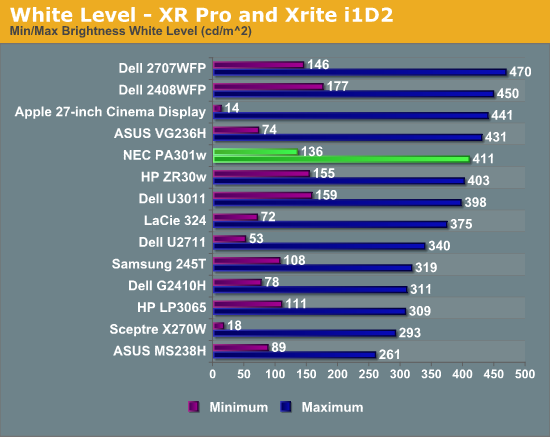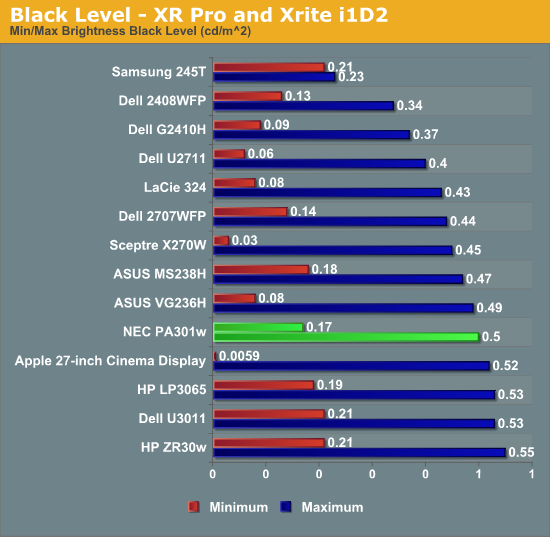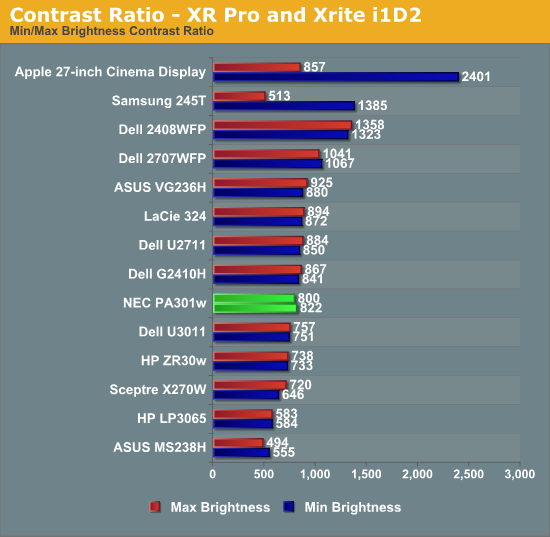NEC PA301w: The Baddest 30-inch Display Around
by Brian Klug on March 1, 2011 8:00 AM ESTBrightness and Contrast
For brightness, black level, and contrast points, we use the same colorimeter setup described earlier. Specifically, we use an Xrite i1D2 with ColorEyes Display Pro, and take measurements at maximum and minimum brightness of white and black targets. Dynamic contrast is turned off. We also let the panels settle in for a half hour at the respective settings before taking any measurements.
The PA301w uses a CCFL backlight, which makes that warm up time even more critical. The PA301w has an interesting quick warmup feature that reduces the visible brightness increase period dramatically. At power on, I measured brightness go from 160 nits (with the OSD showing 200 nits, blinking) to 210 nits in under one minute, then gradually settle to the desired 200 nits. There's a bit of overshoot, but the visual difference is hard if not impossible to actually pick out. For the sake of these tests, I waited for things to settle, but it's actually impressive how fast the PA301w can warm up to totally useable brightness levels.



Brightness settings in the OSD follow the same rules as color ones - if you select something impossible, the last changed value will show up pink, meaning it's outside of the monitor's capabilities. The same thing applies for brightness. I had no problem reaching 411 nits of brightness after getting that worked out - it's a similar thing I've seen on all other displays, sometimes you need to change contrast or color adjustment settings appropriately. Regardless, the PA301w went above the specified 350 nits of brightness, reaching 411. Contrast isn't quite the 1000:1 advertised typical, instead hovering around 800:1 pretty consistently.










92 Comments
View All Comments
bossanova808 - Thursday, March 3, 2011 - link
Having tested this in practise, the 'working quite well' in practice means glitchy as anything. Half the tools don't work properly in terms of rendering around the cursor...if you more thoroughly browse Chris's comments on it in the PS forums, you'll see he acknowledges this.SanX - Tuesday, March 1, 2011 - link
Must be 4K for $2K.Only 100 DPI, or 184 implied DPI ? For $2K ? I see every pixel on it
Griswold - Wednesday, March 2, 2011 - link
Dont talk about things you dont understand, please.bossanova808 - Tuesday, March 1, 2011 - link
Hi FolksIf you're going to start commenting on colour accurate monitor like the NEC PA series or the Eizo CG series, you're going to need to seriously step up both your knowledge and methodology I'm afraid.
You should probably provide a caveat in this review, as the whole colour and uniformity section is pretty much flat out wrong.
For starters, your ED2 is simply not the right sensor to use with sort of monitor - designed quite some years ago now, it's simply incapable of reading the wider gamuts of modern displays accurately. Essentially any other sensor would do better - the Eye One Pro is the obvious choice for you guys I'd say, but really a Munki, Spyder3 or similar would be a better starting point. This has probably lead to the likely very erroneous reading of 5600K for the from factory whitepoint - almost all the PAs seem to come out of the factory bang on 6500K when properly tested. The ED2 is absolutely crap at measuring the primaries on monitors like these.
The NEC sensor has tweaked filters to cope with these monitors and does a much better job but you probably need a general purpose solution like the Eye One Pro.
Further, for calibration, this monitor is crying out to be used with SpectraView2 which is NEC's direct hardware calibration software that can directly manipulate the 14 bit monitor LUTs. Basically, not using this software is kind of defeating the point of using a display like this.
You might want to contact Will Hollingsworth at NEC Colour Critical Displays to have a chat and see if you can't re-visit some of this testing with better methodology & equipment.
eaw999 - Wednesday, March 2, 2011 - link
agreed 100%.bossanova808 - Wednesday, March 2, 2011 - link
...basically, the Mac can't do 10 bit right now (confirmed by both Apple and Adobe), and while the PC has 10 bit support int he OS and it generally works, there are some big issues - Aero effects gets turned off, and apps that sort of support 10 bit like Photoshop have some big glitches still (you can see PS render an 8 bit working square around the cursor with some of the tools that aren't 10 it ready!) - most likely Win8 and Photoshop CS6 will be where 10 bit really comes in to play.softdrinkviking - Wednesday, March 2, 2011 - link
and when 10 bit color finally "comes into play," is it really going to make much of a difference?or should i say, will most people even be able to tell the difference?
DanNeely - Wednesday, March 2, 2011 - link
Probably nto much. The main benefit will likely be being able to render images marked as sRGB on an extended gamut display without banding or over saturation problems.bossanova808 - Thursday, March 3, 2011 - link
Err, dan that isn't right. sRGB rendering on the PA series is already remakrably good and there's no banding issues. The over saturation issues come mainly from non CM stuff, particularly OS elements and the like, that are sent as raw RGB numbers and thus appear quite oversaturated. I think you'll see UI designers tone down the colour going forward...The main benefit will most likely be considerably better control of colour in deep shadows.
softdrinkviking - Wednesday, March 2, 2011 - link
Thanks for the response...This is what I could dig up for the community, or any curious bystanders...
First of all, NEC just redid their whole website like yesterday! so I can't find exactly the same info I was referring to.
But... here is an excerpt from the FAQ for the Spectraview2 software...
" Which is better: a colorimeter or spectrophotometer such as the X-Rite iOne Pro?
In general a spectrophotometer provides more accurate color measurements than a "generic" colorimeter does when measuring most displays. However a colorimeter can be specifically calibrated against a lab grade instrument to match a particular type of display, and thus provide extremely accurate color measurements. This approach was taken with the new custom-calibrated X-Rite iOne Display V2 included in the Display Calibration Bundle.
A spectrophotometer can suffer from drift and low luminance noise issues that can cause problems—specifically when measuring and calibrating near black. In general colorimeters provide superior low luminance measurements than spectrophotometer."
So a couple of interesting things are said here. 1. Colorimeters can be better than uber-expensive spectrophotometers in certain metrics and 2. That NEC specifically calibrates their version of the x-rite meter to compensate for the shortcomings of the colorimeter process.
So, if NEC is to be believed, you need an NEC branded meter to achieve better than so-so results from a generic colorimeter.
here's the link to that, split-up, if you wanna see for yourself...
http:// necdisplay. com /support-and-services/spectra-view-II/FAQ